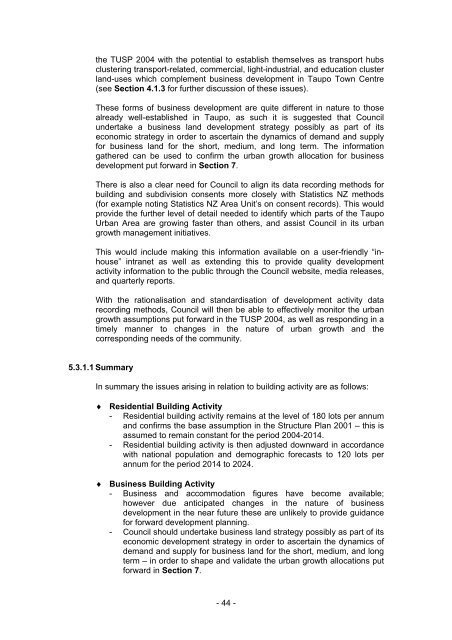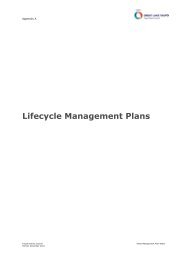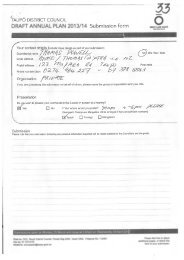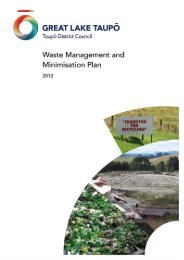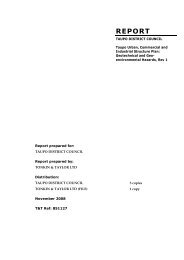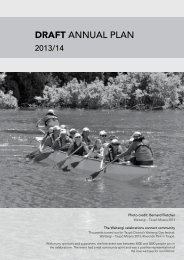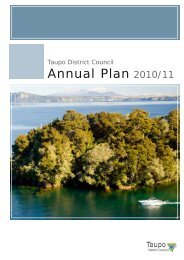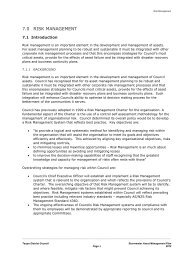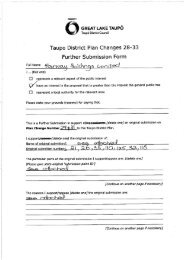Taupo Urban Structure Plan - Taupo District Council
Taupo Urban Structure Plan - Taupo District Council
Taupo Urban Structure Plan - Taupo District Council
Create successful ePaper yourself
Turn your PDF publications into a flip-book with our unique Google optimized e-Paper software.
the TUSP 2004 with the potential to establish themselves as transport hubs<br />
clustering transport-related, commercial, light-industrial, and education cluster<br />
land-uses which complement business development in <strong>Taupo</strong> Town Centre<br />
(see Section 4.1.3 for further discussion of these issues).<br />
These forms of business development are quite different in nature to those<br />
already well-established in <strong>Taupo</strong>, as such it is suggested that <strong>Council</strong><br />
undertake a business land development strategy possibly as part of its<br />
economic strategy in order to ascertain the dynamics of demand and supply<br />
for business land for the short, medium, and long term. The information<br />
gathered can be used to confirm the urban growth allocation for business<br />
development put forward in Section 7.<br />
There is also a clear need for <strong>Council</strong> to align its data recording methods for<br />
building and subdivision consents more closely with Statistics NZ methods<br />
(for example noting Statistics NZ Area Unit’s on consent records). This would<br />
provide the further level of detail needed to identify which parts of the <strong>Taupo</strong><br />
<strong>Urban</strong> Area are growing faster than others, and assist <strong>Council</strong> in its urban<br />
growth management initiatives.<br />
This would include making this information available on a user-friendly “inhouse”<br />
intranet as well as extending this to provide quality development<br />
activity information to the public through the <strong>Council</strong> website, media releases,<br />
and quarterly reports.<br />
With the rationalisation and standardisation of development activity data<br />
recording methods, <strong>Council</strong> will then be able to effectively monitor the urban<br />
growth assumptions put forward in the TUSP 2004, as well as responding in a<br />
timely manner to changes in the nature of urban growth and the<br />
corresponding needs of the community.<br />
5.3.1.1 Summary<br />
In summary the issues arising in relation to building activity are as follows:<br />
♦ Residential Building Activity<br />
- Residential building activity remains at the level of 180 lots per annum<br />
and confirms the base assumption in the <strong>Structure</strong> <strong>Plan</strong> 2001 – this is<br />
assumed to remain constant for the period 2004-2014.<br />
- Residential building activity is then adjusted downward in accordance<br />
with national population and demographic forecasts to 120 lots per<br />
annum for the period 2014 to 2024.<br />
♦ Business Building Activity<br />
- Business and accommodation figures have become available;<br />
however due anticipated changes in the nature of business<br />
development in the near future these are unlikely to provide guidance<br />
for forward development planning.<br />
- <strong>Council</strong> should undertake business land strategy possibly as part of its<br />
economic development strategy in order to ascertain the dynamics of<br />
demand and supply for business land for the short, medium, and long<br />
term – in order to shape and validate the urban growth allocations put<br />
forward in Section 7.<br />
- 44 -


